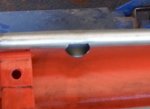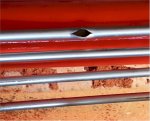Greetings all. Long time reader, first time poster. I have a 2010 L3700SU hydrostatic trans, with LA463 loader and BH-77 backhoe, and about 130 hours on the clock. To date, my tractor has been basically flawless, other than a few small issues that were easily repaired, most of which I attribute to my trying to do a 50 hp tractor's work with a 30 hp model. Yesterday, while lifting a load of wet mud and red clay, I heard a loud pop and saw hydraulic fluid spraying from behind the 4-tube cover on the loader front crossbar. After removing the cover, I found a substantial "blow out" in the #4 tube (top of the four, controls bucket rotation). Any of you ever had a blow out like this before? I am thankful that this occurred behind the cover as it might have been disastrous if it had happened at an exposed location. I attached an image so you can see how severe this was. I was first concerned that the rubbing between the mounting cover and the mounting plate had weakened the tube, but this was actually beside the mounting location so that probably had no impact. I am concerned that all of the other tubes are wedged between the cover and mounting location, and the vibrations might lead to similar failures of the other tubes. Again, anyone else ever have such an event occur? Prior to this event, I had never had the cover off but was surprised to see the metal to metal attachment and vibrational rubs.
Attachments
-
48.8 KB Views: 383



